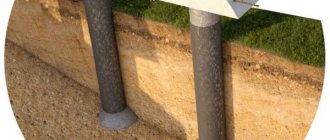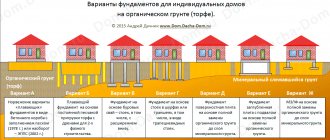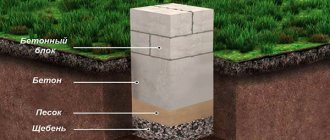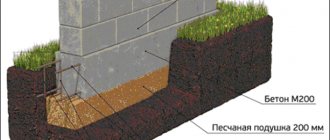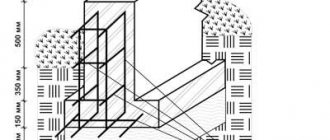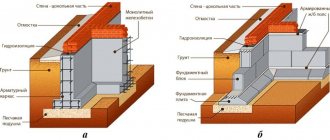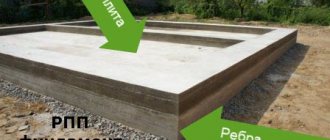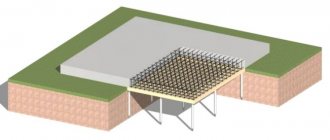When constructing light low-rise buildings, it is economically beneficial to use a shallow strip foundation (MSLF).
They attract developers due to their simple installation, small amount of consumable building materials, combined with a high level of reliability.
We will discuss in the article what features the construction of this type of foundation has, the pros and cons of the foundation and what are the installation rules.
Advantages and disadvantages
MZLF successfully combines the advantages of buried and non-buried foundations and has the following advantages:
- high strength and reliability subject to installation technology;
- simplified excavation work that can be performed without an excavator;
- reduced amount of building materials;
- reduced labor costs for preparing concrete mortar.
There are also a number of disadvantages:
- significant restrictions on the weight and number of floors of the house.
- the need to install a complex drainage system in a heaving area;
- concrete work can only be carried out under stable temperature conditions of more than +10℃;
- The construction of the MZLF is carried out on a flat area or with a slope that does not exceed 5⁰.
Before proceeding with the construction of a shallow strip foundation, it is necessary to carry out a geological survey of the site to determine the possibility of choosing this type of foundation for a house.
In peat areas, on heterogeneous soils, at the junction of different types of soil, in conditions of high groundwater levels, it is impossible to build a shallow strip foundation.
Conditions for calculating the foundation structure
In order to calculate the MZLF and determine the laying depth and width of the tape, it is necessary to take into account:
- type of soil to the depth of the calculated freezing point;
- ground water level;
- freezing depth;
- distribution of weight load on the foundation;
- height differences on the construction site;
- calculated depth, which is equal to the distance from the bottom point of the foundation to the zero level of the building.
The depth of possible soil freezing can be determined according to SNiP 23-01-99* “Construction climatology”.
If there are significant differences in height, it is structurally impossible to install an MZLF. In these cases, leveling the site or constructing a different type of foundation will be required.
The weight load acting on the foundation consists of a constant and variable component. Variables include snow and wind loads, the weight of engineering equipment, furniture, plumbing fixtures, etc. To determine the constant weight component, the height of the building, the materials used, the design of the roof and ceilings, and other design features are taken into account.
To quickly perform the calculation part, it is recommended to use the MZLF online calculator.
MZLF device diagram
A reinforced concrete strip must be installed around the perimeter of the base of the house, all load-bearing walls and partitions. Almost half of its height is above ground level and forms a base.
Schematically the device looks like this:
- a pillow made of coarse sand (0.3 - 0.4 m wide and 0.2 m high);
- monolithic reinforced tape (with a recess of up to 0.5 m, the width depends on the thickness of the walls, on average 0.4 m);
- heat and waterproofing along the entire length of the tape and blind area for drainage of melt and rain water;
- decorative cladding (material for cladding at the request of the customer).
Visually, the device diagram looks like this:
One of the important conditions for the possibility of constructing a shallow belt is the absence of a seismic threat above 6 points.
SGround.ru
Main features and subtleties of surface foundations
Table of contents
- Basic provisions
- Types of surface foundations
- Features and possible problems of shallow foundations
- Behavior of shallow foundations under the influence of frost heaving
- What to consider when designing and constructing shallow foundations
- Reducing the impact of frost heaving on surface foundations
- Examples of design solutions for shallow foundations
- Conclusion
- Related Articles
Basic provisions
Although foundation design standards state that the depth of the foundation in heaving soils should be greater than the freezing depth, this solution eliminates only the frontal forces of frost heaving, but does not eliminate the tangential heaving forces on the side surface, which are also very large and the load from a light low-rise building cannot influence them. resist. And in the northern regions of the Russian Federation, the standard freezing depth varies from 1.5 to 3.0 m or more. In such a situation, the option of a surface foundation should be considered.
A shallow or surface foundation is one of the simplest and most economical options for lightweight buildings and structures - it has minimal costs for materials and almost complete absence of excavation work. But despite its apparent simplicity, this type of foundation has features that must be taken into account both at the design and construction stages.
Shallow foundations include all types of foundations if the depth of their base does not exceed the standard freezing depth of the heaving soil of the foundation, that is, the foundations are completely located in the zone of seasonal freezing/thawing of soils
This article considers only superficial and practically shallow foundations (depth no more than 20 cm), because if the foundations are deepened, but less than the freezing depth, then they will accumulate heaving deformations year after year without completely returning to their original position after the soil thaws, and their use is absolutely unjustified. If the foundation still has some depth, then it is necessary to backfill the pit sinuses of sufficient width with non-heaving material (medium and coarse sand, ASG. The width of the sinus should be no less than the depth of the foundation) and provide measures to ensure that the foundation slips relative to the ground along the side surface to ensure free subsidence of the foundation after lifting by frost heaving.
Deepening the foundation without taking special measures is not the right decision
It makes sense to use shallow and shallow foundations in the construction of low-rise buildings, dachas, garages, outbuildings, bathhouses, etc. They can be used in the construction of log houses or walls made of cellular concrete, and in the construction of frame-panel houses. Naturally, application is limited to buildings without a basement.
The use of shallow and surface foundations for brick houses is not recommended walls made of brick and other stone materials are very sensitive to foundation deformations and crack at the slightest displacement (reinforced masonry is more stable, but still very fragile). They should also not be used for two- or more-story buildings due to the heavy load on the base and foundation, and their load-bearing capacity is often severely limited.
Crack in masonry due to foundation displacement
According to the note to clause 6.8.10 SP 22.13330.2016 Shallow foundations can be used for the construction of a reduced level of responsibility and low-rise buildings with a standard freezing depth of no more than 1.7 m. And, for example, the Guide, clause 4.22 states that the freezing depth under the sole a shallow foundation should be no more than 1.0 meters , and under the bottom of a buried foundation no more than 0.5 m.
Regulatory requirements for shallow foundations are given in section 8 of SP 22.13330.2016 “Features of the design of foundations and foundations of low-rise buildings”, which can be downloaded in the REGULATIONS section at this link. This section is required reading if you plan to use such foundations.
According to clause 8.6 of SP 22.13330.2016, when designing shallow foundations on heaving soils, it is necessary to perform verification calculations for heaving deformation (for raising foundations).
Types of surface foundations
Shallow and surface foundations can be of the following types:
- Tape;
- Columnar (these also include “piles” of shallow immersion depth (less than the depth of soil freezing). In fact, these are not piles, but separate columnar foundations since a real pile, by definition, has an immersion depth of at least 4.0 meters) ;
- Slab;
Any of these types of foundations will be considered shallow if its base lies above the standard freezing depth of the heaving soil of the foundation. If the base soil is not heaving, then this classification is not particularly important.
To determine the characteristics of foundation soils, you should contact specialized survey organizations or, as a last resort, use the instructions in this article.
The maximum load-bearing capacity, naturally, will be inherent in the slab version due to the large area of support on the ground, as well as the maximum cost and labor intensity.
Surface slab foundation
Strip foundations (if properly designed) have sufficient load-bearing capacity. This refers to monolithic continuous strips of reinforced concrete, or strips of large blocks with a monolithic reinforced belt along the top and a monolithic bottom slab. Without additional measures, tapes made from FBS blocks do not provide the necessary strength and rigidity.
Shallow strip foundation
Columnar shallow foundations on heaving soils should be used only in combination with a monolithic continuous frame (usually a reinforced concrete system of cross beams), combining them into a single whole, or for completely unimportant structures without a common rigid frame (sheds, storage rooms, verandas, gazebos, etc. . buildings of III level of responsibility). In general, their use is very limited and is not recommended for more or less critical structures.
Shallow columnar foundations
All types of foundations and their features are discussed in detail in this article.
Features and possible problems of shallow foundations
- The main feature of shallow and surface foundations is that they are subject to the frontal forces of frost heaving. And considering that such foundations are usually used for lightweight structures, the load on the soil underneath them is small and cannot in any way withstand the enormous forces of uplifting swelling soil, we can safely say that when the soil freezes, the foundation will move, shift vertically - that is, “walk.” This negative effect can be reduced by insulating the soil, but it is very difficult to completely eliminate.
But a huge advantage of surface and practically non-buried foundations is that after the soil thaws, they return to their original position without accumulating heaving deformations.
- The next feature stems from the first – because. the foundation, and along with it the building, shifts vertically from frost heaving, then the stairs, porches, and extensions adjacent to it from the outside must be adapted to such displacements.
- In the summer (that is, in an unfrozen state), soil layers close to the surface have a much lower bearing capacity than those lying at depth (this phenomenon is explained in the article in subsection “4. Dependence of the foundation depth on the strength of the foundation soils and the load on foundation"), therefore, the bearing capacity of the foundation should be carefully checked by calculations and, if necessary, its area, depth or other measures should be increased.
- As a rule, the foundation has a sufficiently high height above the ground level. This is due to the fact that it needs to be given sufficiently great rigidity and strength, for this you need
Behavior of shallow foundations under the influence of frost heaving
Almost always, frozen soil rises unevenly (the reasons are described in the article on the physics of the heaving process). Uneven heaving affects shallow foundations causing:
- If the foundation is solid and strong enough to bear the loads from the building after the uneven rise of the freezing soil, then it rises and experiences rolls, but remains practically unchanged in shape, i.e. the upper plane of the foundation remains flat, although it tilts or shifts vertically (of course, in fact, the surface bends to a limited extent depending on the rigidity of the foundation). In the spring, after the soil has completely thawed, the foundation will return to its original position, restoring its original shape.
- If the strength of the foundation is not enough, then the foundation collapses - wide cracks and chips of concrete appear. After the soil thaws, the shape of the foundation will not be completely restored.
What to consider when designing and constructing shallow foundations
First, you should study the documents:
- Recommendations for the design and calculation of shallow foundations on heaving soils NIIOSP im. N.M. Gersevanov 1985
- Guidelines for the design of foundations and foundations on heaving soils NIIOSP im. N.M. Gersevanov 1979
- TSN MF-97 MO “Design, calculation and installation of shallow foundations of low-rise residential buildings in the Moscow region” - Moscow 1998 - when studying this document, keep in mind that the Moscow region has a warmer climate than in Siberia and the freezing depth they take is no more than 1, 5 m.
Consider the following key points when designing:
- To ensure that movements of the foundation from frost heaving do not cause damage to the above-ground part of the building (cracks in the walls, broken glass) and generally do not cause any problems in the future (jammed doors, skewed porches, etc.), the foundation must be solid, continuous under the entire building, or better yet and under the porch, and have sufficient rigidity and strength to retain its original shape and not break due to uneven lifting of the freezing soil. To ensure the required strength and rigidity, it is necessary to perform calculations of the foundation and reinforcement taking into account the uneven displacement of the base. It is better to perform calculations for various variants of uneven displacement of the base in a finite element program (for example, SCAD or others); manual calculations will be much more difficult (especially for slab and complex-shaped strip foundations).
An example of the result of calculating the reinforcement of a monolithic strip in the SCAD program
- The presence of a soil-vegetative layer should be taken into account - if the foundation is rested on organic fertile soil, then as a result of the decomposition of organic matter, large settlements of the foundation, extended over time, are guaranteed. In addition, the soil-vegetative layer has a very low bearing capacity and cannot serve as a load-bearing foundation. This weak layer must be completely replaced, usually with a sand cushion.
- The low bearing capacity of the upper layers of soil should be taken into account. Soil layers close to the surface have a much lower bearing capacity than those lying at depth, so the bearing capacity of the foundation should be carefully checked by calculations and, if necessary, its area, depth or other measures should be increased.
- Porches, external staircases and other parts of the building supported on separate foundations must have movable attachments to the main structure, allowing mutual movements of up to 10 cm or more (depending on the degree of heaving of the soil and the depth of freezing) or generally be independent of the main building.
- Measures should be taken to reduce the impact of frost heaving on foundations. For example, insulation of the blind area, side surfaces of the foundation, soil under the building (for heated buildings, use minimal insulation so that heat can partially penetrate into the soil). This will reduce the depth of soil freezing under the base of the foundation and near it, especially effective for heated buildings.
The influence of insulation of the blind area and foundation on soil freezing
Reducing the impact of frost heaving on surface foundations
To reduce the impact of heaving on surface foundations, the following measures are used:
- Replacement of part of the heaving soil under the foundation with non-heaving soil (coarse or medium-sized sand, crushed stone, gravel, ASG, etc.);
- Construction of foundations on a locally compacted base (in rammed/stamped pits, trenches, foundations made of driven blocks) - see TSN MF-97 MO "Design, calculation and installation of shallow foundations of low-rise residential buildings in the Moscow region"
- Application of insulated blind area around the perimeter of the building. More suitable for heated buildings with ground floors;
- Drainage installation around the perimeter of the building, general water reduction on the site;
- Introduction of anti-heaving components into the soil.
For more information on measures to combat frost heaving, see this article.
Examples of design solutions for shallow foundations
Drawings from TSN MF-97 MO:
I repeat once again - although we are talking about shallow foundations for brick buildings, the use of such solutions is very dangerous, and the consequences of uneven soil deformations cannot be eliminated without dismantling the walls.
Conclusion
Surface (shallow) foundations have their own rather narrow area of application. Their main disadvantage is their susceptibility to frost heaving and shifts in height in winter. Their main advantage, in addition to simplicity and low cost, is that the presence of heaving deformations is known in advance and these deformations will definitely be reversible and not accumulate year after year.
When designing and constructing such foundations, one must take into account many of their features, perform detailed calculations, and think through many details related to the mobility of the foundation, and therefore the entire building/structure.
Related Articles
- Choosing the depth of foundations
- Engineering-geological surveys – mandatory or not?
- What are heaving soils?
- How to determine soil type by visual signs
- Measures to combat frost heaving
- Section Standards
SNiP requirements
SNiP imposes strict requirements on the minimum depth of the foundation cushion:
- 1 m (if the soil freezes from 3 m or more)
- 75 cm (when the soil freezes to a depth of 3 m);
- 50 cm (if the soil freezes less than 2 m).
According to the standards, the reinforcement is laid in the foundation in such a way that at least 6 cm remains to the edge of the concrete pouring. The rods are connected to each other with knitting wire. Special requirements are also imposed on the distance between the reinforcement bars, as well as the spacing of the transverse reinforcement. You can learn more about the basic requirements by following this link.
As practice shows, in the regions of the middle zone the depth of the MZLF will be about 0.5 m . For small outbuildings and country houses, this value can be reduced to 0.3 cm.
Foundation installation materials and technology
The technology for installing MZLF depends on the type of building material from which the walls of the building or structure will subsequently be erected.
For a house made of expanded clay blocks
The average density of an expanded clay block is 300-900 kg/cubic. m. This allows the use of a shallow monolithic strip base for a one-story building made of expanded clay block.
Due to the high porosity of expanded clay, the foundation needs good waterproofing . All walls of the tape inside and outside along the perimeter are covered with hydrophobic substances: mineral or bitumen mastic, roofing felt or film.
A horizontal waterproofing layer is applied to the sand bed before the concrete strip is poured.
Made of brick
Brick houses have their own characteristics. Brick perfectly resists vertical loads, but it is weak in bending and stretching. In case of uneven shrinkage of the foundation or partial bulging of the soil, the walls will collapse.
Therefore, a shallow strip base is chosen for small buildings and only on dense soils that are not prone to heaving. In other situations, it is better to install a solid concrete slab , which will evenly distribute the load and prevent soil displacement.
Only a powerful solid monolithic foundation can withstand the load from a large brick or stone building.
For frame
A shallow solid reinforced concrete strip can be used as a base for low-weight frame houses on sandy, sandy loam and rocky soil.
If the area is too saturated with moisture, specialists consider the possibility of using this type of foundation.
From logs
For a log house, a reinforced foundation in the form of a shallow strip is built only on sand, stone or gravel soil.
According to construction standards, the foundation depth for regions in the middle zone on non-heaving soil will be at least 0.6-0.8 m, on heaving soil - up to one and a half meters. Therefore, choosing MZLF for heavy log houses is dangerous.
For aerated concrete
Aerated concrete has a high heat-saving ability with low weight.
Walls made of this building material can be twice as thin as brick walls with the same heat-saving effect.
Therefore, for a one-story building that is being built on normal non-heaving and slightly heaving soils, it makes sense to make the base from MZLF in order to save on the foundation.
The width of the base should be at least 0.3 m. When the soil is heaving, under the foundation it is replaced with coarse sand and compacted well.
To achieve high efficiency, the thickness of such a cushion under the tape is made at least 0.2 m, in difficult situations at least 0.8 m.
Read what else you need to know about a strip foundation for a house made of aerated concrete here.
Basic concept
The main problem of complex soils is heaving during freezing, which causes them to significantly increase in volume. This factor leads to the gradual destruction of the foundation and the entire building. This can be avoided by balancing the buoyant force by increasing the load on the foundation, that is, the weight of the building, but private houses and summer cottages are lightweight buildings, so deep types of foundations, including pile ones, are not suitable here. The solution to the problem is a shallow foundation.
The very name of the structure already makes it clear what shallow foundations (FMF) are. Its depth is from 40 to 50 cm, which significantly reduces the impact of soil during heaving on the lateral area of the walls of the building.
The minimum depth of the foundation helps reduce financial costs and time for its installation by at least 2 times.
In this case, significantly less concrete, crushed stone or sand is required to make the substrate and material for constructing the formwork. The components of the design are:
- the edge is the upper part that takes the load from the house;
- lower part transmitting load;
- side parts, that is, walls.
Such foundations are not built directly on the ground; they are mounted on a bed of sand, fine-grained crushed stone or slag, previously compacted with high quality.
Approximate diagram of laying a sand cushion
How to do it yourself?
To build a shallow reinforced strip foundation, you will need to perform the following steps:
- calculate the width of the foundation, the cross-section of the reinforcement;
- make a reinforcement drawing;
- clear away debris and plan the area;
- dig trenches;
- lay a drainage layer;
- arrange a footing or lay roofing felt;
- install formwork;
- lay and fasten the reinforcement;
- insert sections of pipes for communications and ventilation;
- perform concreting of the tape;
- provide care for concrete during its setting;
- remove the formwork from the tape;
- waterproof the foundation.
Then all that remains is to make a blind area and line the foundation with waterproof material. Each stage of construction of the MZLF has its own nuances.
Necessary calculations
When calculating the foundation , it is taken into account that its laying depth is equal to the freezing depth, minus 25%.
Failure to comply with this requirement results in heaving of the soil and there is a risk of compromising the integrity of the structure.
The height of the base should not exceed the size of the underground part of the base.
To calculate the width of the structure, it is necessary to calculate the ratio of the weight load (t/m) to the calculated soil resistance (t/m2), (based on tabular data SNiP 2.02.01-83). The thickness of the sand-crushed stone platform is determined according to SNiP data.
Detailed information about the calculations in our article at the link.
Preparatory work and marking
The fertile layer is removed and the construction site is graded. At the intersections of the foundation and in the corners, stakes are driven in and a rope is pulled.
Digging a trench and arranging a cushion
The trench is dug to the required depth. Level the walls and corners if heavy equipment was used.
There is no need to plan the bottom of the trench to fanaticism. Pour a layer of clean coarse sand, without plant debris and clay. They tamp down, spilling water. Fine crushed stone is poured in and compacted as well.
A top leveling layer 50 mm thick is installed. The platform is covered with geotextiles, a footing is poured or roofing felt, folded in half and coated with bitumen, is laid.
There is a detailed article about the types of pillows and the features of the device for strip bases here.
Formwork assembly
The formwork is assembled from edged boards 25-40 mm thick. The shields should rise slightly above the tape. Be sure to inspect the cracks.
Builders practice covering formwork with plastic film . The formwork is fixed in place using external stops and internal spacers are installed.
Full information about formwork installation is here.
Reinforcement
The tape is reinforced with a reinforcement cage. Workers are considered to be horizontal rods that accept external loads. Vertical ones play a supporting role. The frame is knitted by twisting it with steel wire . The rods will have mobility and compensate for the resulting loads (when pouring concrete mortar or an earthquake). Welding will not withstand such loads.
The quality of MZLF is greatly influenced by properly executed reinforcement. It is important to correctly calculate the diameter of the reinforcement and the number of rods.
All details of reinforcement of strip bases are here.
Pouring concrete
The concreting process is carried out without interruptions, not exceeding a pause of more than a day. Otherwise, a monolith will not work.
It is advisable to order delivery of the solution or organize its continuous production on site at the required pace.
The pouring process begins from the internal areas with a smooth transition to the external perimeter. You cannot pour concrete at one point and wait for it to spread over the tape. Fill the formwork at once from different points, evenly distributing it along the length.
Next, the surface is covered with polyethylene from hot sunlight. For the first 3 days, the tape is moistened after 4 hours, then another week after 8 hours to extend the setting time of the concrete. This ensures the strength of the monolith. After 10 days, the formwork is removed. After a month, construction can continue.
You cannot shorten the time it takes to complete the concrete strip. In order for the foundation to fulfill its purpose, the tape must not be loaded prematurely.
Formwork removal and waterproofing
Removing the formwork does not mean the end of the construction of the MZLF. It is necessary to perform horizontal waterproofing using two layers of rolled roofing material and coat the side surfaces of the foundation with bitumen.
You can use any impregnating and coating materials that prevent moisture penetration. Reliable waterproofing will protect your home from destruction and mold development.
The sinuses on the outer and inner sides of the foundation are filled with sand and a blind area is created that will protect the foundation from rain and melt water. If everything is done correctly, the water will flow along the concrete strip towards the drainage well.
Insulation of the base and blind area
To insulate the base and blind area, penoplex, penofol, liquid polyurethane foam, etc. are used. Any insulation with moisture-proof properties will be suitable, depending on the developer’s budget. The tape is insulated from the inside over the entire surface, except the horizontal one.
Stages of construction of a shallow strip foundation
When laying a concrete strip with your own hands, it is important to adhere to standard technology, take into account geological and geodetic features, and remember the recommendations of specialists. Installation begins with the preparatory part, which includes marking. After completing the excavation work and backfilling the sand cushion, they proceed directly to the construction of the belt itself: they install the formwork, prepare the reinforcement, and pour the concrete.
Preparation and marking of the site
At the construction site, debris is removed, trees and bushes are uprooted, and the ground is leveled. If the area has a significant difference in elevation, then soil removal and leveling is mandatory, since the MZLF cannot be erected under such conditions. Construction materials are delivered to the construction site and storage areas are arranged. They should not be harmed when weather conditions change.
After this, they begin marking. For this part of the work you need a cord, a construction level, a tape measure, and pegs for beacons. To make a beacon, nail a board onto two wooden pegs. Using this simple design, the width of the future foundation is noted. First, the cord is pulled along the outer border of the tape. The inner line is marked after the trench is ready. During the marking process, be sure to check the geometry of all perimeter corners.
Excavation
This part of the job involves digging a trench. Its depth is equal to the sum of the height of the sand cushion and the depth of the base. The average data for central Russia are 200 mm and 300 mm, respectively. Thus, the total depth of the trench is 500 mm. The maximum depth, if calculations require it, can reach up to 1.5 meters (with a freezing level of 2.5 meters).
A trench is dug 200-300 mm wider than the concrete strip itself. In this case, the longitudinal recess should have small slopes (120-250 mm). They are needed to prevent the soil from falling off and to provide convenient access to the object during waterproofing work.
Preparing the pillow
Sand and crushed stone are used for backfilling. This can be a crushed stone-sand mixture, which is used in road construction. You can also fill these materials separately. In this case, layers of sand and crushed stone alternate, leaving sand as the topmost layer. With this method of constructing a cushion, crushed stone should account for at least 3/4 of the total volume of materials. Each layer is carefully compacted by hand or using a construction vibrator.
When the underlying layer is ready, it is covered with a waterproofing layer. Its role can be played by roofing felt or geotextiles. The latest type of waterproofing agent allows moisture to pass through in only one direction and protects the foundation. Another function of non-woven material is to protect concrete from possible plant germination.
Installation of formwork
The frame for pouring concrete is installed at the entire height of the foundation, so its upper part will rise above ground level. The formwork is assembled from boards or ready-made panels. The boards are connected to each other by transverse bars. To ensure that the structure remains stable, it is fixed with inclined supports. They are installed every 0.5 meters.
In parallel with the installation of the formwork, the sleeves necessary for wiring utilities are laid. Metal or asbestos-cement pipes with a diameter of at least 20 cm are suitable for this purpose.
Reinforcement and knitting
To increase the strength and reliability of MZLF, reinforcement should be a mandatory step in the installation process. The finished reinforcement is a structure of longitudinal, transverse and vertical metal rods connected to each other by annealed steel wire. For high-quality reinforcement of MZLF, longitudinal metal strings of 12 mm, transverse and vertical - 8 mm are used.
Knitting of reinforcement is carried out by conventional twisting of wire. To do this, cut segments 25-30 cm long. Bend the steel thread in half and place it diagonally under the joint of the rods. Raise the ends of the wire up and wrap the elements. Then a special hook is inserted into one of the loops and the ends are twisted 4-6 turns. In rare cases, welding is used to connect elements. But this method is not recommended, as it reduces the strength of the reinforcement.
The metal skeleton is installed in the trench so that it does not touch the bottom. To do this, blocks or pieces of brick are placed under it.
Pouring concrete mixture
The solution for pouring into the formwork can be ordered ready-made. If you decide to prepare it yourself, then you will need cement, sand and crushed stone. When choosing M400 cement, these ingredients are taken in a ratio of 1:2.5:4. With M500 cement the ratio is 1:3:5.
The concrete mixture is compacted using a submersible construction vibrator. In the absence of this equipment, the solution is poured in layers of 3-5 cm, compacting each layer. Compaction is necessary to remove air bubbles that reduce the density and strength of the foundation.
The process of filling the formwork begins with the internal sections, moving to the external perimeter lines last. After complete pouring, the concrete is given at least four days to harden. If during this stage of work the weather is dry and hot, the concrete strip is covered with polyethylene. Periodically, the surface of the concrete is watered to prevent cracking. The formwork is removed after 10 days, counting from the day of pouring. Further construction work can begin only after four weeks.
Subtleties of construction
When it is possible to mount support piles below the freezing level of the soil, a shallow strip foundation is built in conjunction with support pillars.
This option is used for damp and marshy areas, on loams, and with close-lying groundwater. This allows you to save on the supporting structure without compromising its reliability.
The following are used as pillars:
- steel pipes protected by a concrete layer;
- reinforced concrete supports;
- asbestos-cement pipes filled with concrete inside.
It is necessary to consider the arrangement of a high-quality drainage system. Otherwise, the costs of arranging the foundation will not be justified and the structure will collapse over time.
Installation of a shallow columnar foundation
This type of base is suitable for bathhouses and small wooden houses, as well as structures made of light building materials, for example, summer houses made of plasterboard or chipboard. The main advantage of such a foundation is rapid construction and minimal construction costs. It includes the following steps:
- Design and calculation of the foundation. Experts recommend conducting a laboratory analysis of the soil in order to determine the exact depth of the pillars depending on the depth of its freezing.
- Calculation of the distance between pillars (for monolithic products this is 100-120 cm).
- Performing markings.
- Digging a hole around the perimeter of the foundation, its thickness should correspond to the cross-section of the pillars.
- The pit is filled with crushed stone up to 20 cm thick, it is carefully compacted.
- Implementation of a reinforced structure. First, rods are installed at the width of the foundation, then longitudinal parts are attached to them. The grating can be mounted either in the pit itself or in a separate area with subsequent immersion of the structure into the trench.
- Pouring with concrete grade 250.
- Making a box from long edged boards; it should not have a bottom.
- attaching formwork to pre-erected reinforcement structures.
- Filling the formwork with cement mortar of the same brand.
- Making a fence and a bitumen layer that protects it from moisture.
For the most durable use of this type of foundation, you should adhere to a few simple rules:
- correct calculation of the foundation;
- the uniform load is not its total area and individual elements;
- selection of exclusively high-quality materials both when pouring the foundation and when constructing formwork;
- All work should be carried out in summer or early winter.
Columnar elements should stand from two weeks to a month until the concrete hardens completely.
In the video provided below, you can understand the basics of how FMP is performed: If you adhere to all the rules listed above, a shallow foundation will become a very economical and convenient option for creating the foundation for a private building. It should be used in private construction and in certain soil conditions.
Features of construction on heaving soils
In an area where the soil is prone to baking, a foundation is built only after measures have been taken against this phenomenon. You need to be prepared for the fact that you will need to carry out expensive and time-consuming activities associated with excavation work.
A radical method is to replace the heaving layer with coarse river sand. To do this, build a pit with a depth well below the freezing level of the ground, cover it with a thick sand layer and compact it thoroughly.
For lightweight structures, the insulation method can be used to combat soil heaving. The width of the insulation is selected individually and depends on the climate in the region. It should not be less than the freezing depth.
Additional information about the features of this type of foundation on heaving soils is here.
Advantages and disadvantages of the foundation
The main advantages of a shallow strip foundation are:
- The cost of such a base is significantly lower than any other type by 2-3 times.
- The consumption of materials for its construction is reduced.
- It does not require the involvement of heavy equipment and specialists for arrangement, which makes it possible to build it yourself.
- There is a possibility to make a semi-basement.
- Compared to non-buried structures, it is less susceptible to heaving phenomena.
- It has good strength for small houses, bathhouses or wooden houses.
However, this type of foundation is not without some disadvantages, which include the fact that it can withstand small loads, so it is not recommended to be used for full-fledged construction. It is also not suitable for construction on unstable soils, on frozen ground and cannot be left unloaded during the winter.
Prefabricated base on sandy soils
A strip foundation, buried to 0.4-0.6 m, on coarse sandy stable soils will serve as a reliable foundation for most types of buildings.
The following options for its design can be considered:
- pouring concrete with reinforcement;
- installation of concrete blocks;
- rubble stone masonry.
Waterproofing the trench will help the concrete gain strength as it matures. Soil with a predominant substrate of silty sand is subject to seasonal deformations and will not act as a reliable foundation base. The MZLF must be strengthened with columnar supports.
